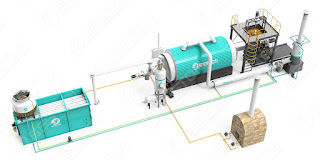Tyre Pyrolysis Plants Is Able To Reduce Environmental Concerns Brought on Waste Tyres
Our prime utilization of vehicles for transportation requires using rubber tyres that will get worn-out right after a time, and have to be disposed of. Earlier these were just discarded in landfills and greatly led to environmental degradation. Technology has found a solution of employing pyrolysis to process the waste tyres and convert them into useful byproducts.
A scrap tyre pyrolysis plant includes a reactor when the waste tires are gently heated by making use of fuel like coal, wood, LPG, natural gas, or others. This reactor will have an automated feeding machine to feed it with all the waste tyres. These tyres are often shredded prior to being heated, as this greatly raises the portion of the rubber which needs to be burnt and hastens the procedure. Shredders will often be a part of pyrolysis plants and stay installed just before the reactor and can deposit their materials into the feeding devices.
Once high temperatures are reached inside the reactor, this can release oil gas and will also be passed onto condensers that may liquefy the oil and store it in tanks. Lighter gas that is not going to condense could be further treated and fed into the furnace for use as fuel. This could help reduce fuel costs for running the waste tyre to oil plant.
When the fuel oil is produced the reactor needs to be capable to cool down. At these lower temperatures, carbon black is discharged automatically. This is an important byproduct that sees use in many industries. If we have seen steel in the waste tyres being melted, this must be removed separately with hooks or magnets and is also a helpful byproduct that may be sold to recyclers for use.
Some tyre pyrolysis plant is created to work continuously without stoppage for that recovery of byproducts, to make for economical running, as when the reactor is initially charged and fired up, it remains working continuously using the oil gas for fuel, and with arrangements intended to recover the carbon black and steel wires, without interrupting the production process. These plants need a high standard of automation in comparison to plants that actually work with a batch basis. These plants may just need to be stopped for any maintenance or repairs and working non-stop to get a month or maybe more will not be unknown. They, however, require a lot of care in the material that is certainly fed into them, simply because this needs to be of a constant quality that meets the specific plant. Batch plants can alter their feed quality after every batch. The oil manufactured by tyre pyrolysis plants is effective and it is utilized in furnaces as well as other devices which need heating.
Tyre pyrolysis plants in addition to their associated technologies have greatly addressed the environmental problem brought on by the creation of more than 1.5 billion tyres each and every year that ultimately need replacing and become waste material which needs to be discarded. These plants may also be used for waste plastic, oil sludge, and also other waste that can produce similar byproducts following the necessary treatment. See small scale pyrolysis unit here.


Comments
Post a Comment